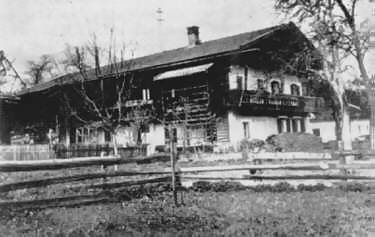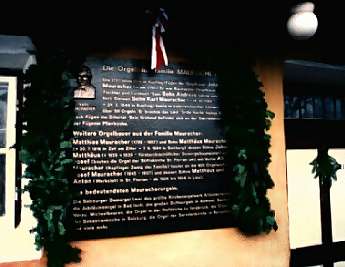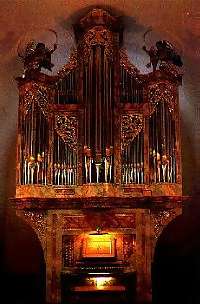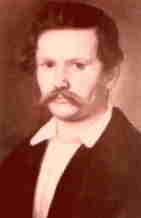When Karl Mauracher returned to his home in the Ziller Valley after working on the organ at St. Nicholas Church, he had with him the words and melody for "Stille Nacht!" It is not known if he was given a manuscript or if he saw the song lying on the organ and copied it for his own use.
He passed on the song to two neighboring families who were well-known for their singing abilities - the Strassers and the Rainers. Both families included it in their repertoire and it began its journey around the world as the "Tirolean Folk Song."

The Mauracher home in the Ziller Valley is privately owned. It is hoped that one day it can be converted into a museum dedicated to the man responsible for the dissemination of Silent Night. |
 This plaque tells of the Mauracher men who lived in this house while they designed and built organs for numerous churches in Austria. This plaque tells of the Mauracher men who lived in this house while they designed and built organs for numerous churches in Austria. |
Mauracher Organ Restoration
Following the recent renovation of the parish church of Sts. Dgydius and Sylvester in Reith bei Kitzb�hel, Austria, it was decided that something needed to be done about the dilapidated condition of the old organ which had been moved to the choir loft. The pastor, Fr. Gerhard Erlmoser, formed a parish organ committee and it was decided to solicit bids for the repair of the organ. In October 1998, the organ commission from the Archdiocese of Salzburg arrived in Reith to study the instrument. The commission chairman, Prof. Dr. Gerhard Walterskirchen, was impressed with the beauty of the organ and stated that it should be preserved as "it is a one-of-a-kind historical instrument."
|
 Some experts believe that this is a Mauracher organ from the family of organ builders in the Zillertal. The founder of the firm was Andreas Mauracher(1758-1824), then came his son Karl(1789-1844) and Matthias(1788-1857), as well as one more generation of organ builders.
|
 One clue that led historians to believe that this could be a Mauracher organ is the inlaid bone in the register knobs(stops). The writing on the wooden ridge to the left of the stops is not original. The panel was removed by Austria's Federal Office for Preservation and sent to Vienna. There, the top layer will be stripped and they hope to find the original writing underneath. By comparing the writing with other examples of Mauracher's penmanship, it is hoped to add to the evidence pointing to the designer/builder of this valuable instrument.
|
 Through the years, make-shift repairs have been made on the organ. During one attempt at repairs, softdrink cans were inserted into some of the pipes (left) to keep them from further collapse. Plans call for the organ to be put back to its original condition and the cost is expected to be around $83,000. The preservation office says the organ was built sometime between 1820 and 1830. Despite renovations and moving, its appearance has stayed in nearly the same form as it was originally designed.
|
 This magnificent organ is a wonderful example of the craftsmanship that can be found in Austria. Though it looks as if it is from another century, it was built in 1996 for the parish church in Kirchberg in the Austrian Tirol. Just as Fr. Erlmoser was the principal mover and shaker in the building of this organ in his Kirchberg parish, he is carefully watching over the renovation of the historic organ in his parish at Reith.
|


 This plaque tells of the Mauracher men who lived in this house while they designed and built organs for numerous churches in Austria.
This plaque tells of the Mauracher men who lived in this house while they designed and built organs for numerous churches in Austria.



